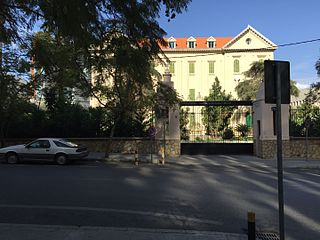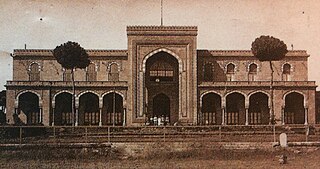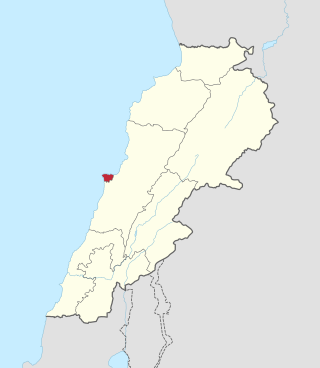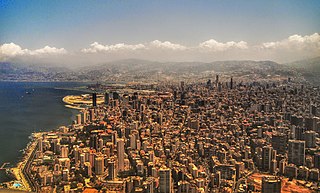The foreign policy of Lebanon reflects its geographic location, the composition of its population, and its reliance on commerce and trade. Until 2005, Lebanon's foreign policy had been heavily influenced by Syria, however beginning with the formation of Hezbollah in 1982, Iran had gradually grown to heavily influence Lebanon.

Beirut is the capital and largest city of Lebanon. As of 2014, Greater Beirut has a population of 2.5 million, which makes it the third-largest city in the Levant region and the thirteenth-largest in the Arab world. The city is situated on a peninsula at the midpoint of Lebanon's Mediterranean coast. Beirut has been inhabited for more than 5,000 years, making it one of the oldest cities in the world.
The Islamic Jihad Organization, was a Lebanese Shia militia known for its activities in the 1980s during the Lebanese Civil War.

Imad Fayez Mughniyeh, alias al-Hajj Radwan, was a Lebanese militant leader who was the founding member of Lebanon's Islamic Jihad Organization and number two in Hezbollah's leadership. Information about Mughniyeh is limited, but he is believed to have been Hezbollah's chief of staff and understood to have overseen Hezbollah's military, intelligence, and security apparatuses. He was one of the main founders of Hezbollah in the 1980s. He has been described as "a brilliant military tactician and very elusive". He was often referred to as an ‘untraceable ghost’.

Early on a Sunday morning, October 23, 1983, two truck bombs struck buildings in Beirut, Lebanon, housing American and French service members of the Multinational Force in Lebanon (MNF), a military peacekeeping operation during the Lebanese Civil War. The attack killed 307 people: 241 U.S. and 58 French military personnel, six civilians, and two attackers.

Achrafieh is an upper-class area in eastern Beirut, Lebanon. In strictly administrative terms, the name refers to a sector (secteur) centred on Sassine Square, the highest point in the city, as well as a broader quarter (quartier). In popular parlance, however, Achrafieh refers to the whole hill that rises above Gemmayze in the north and extends to Badaro in the south, and includes the Rmeil quarter.

The Lebanese Forces is a Lebanese Christian-based political party and former militia during the Lebanese Civil War. It currently holds 19 of the 128 seats in Lebanon's parliament and is therefore the largest party in parliament.

The Multinational Force in Lebanon (MNF) was an international peacekeeping force created in August 1982 following a 1981 U.S.-brokered ceasefire between the Palestine Liberation Organization (PLO) and Israel to end their involvement in the conflict between Lebanon's pro-government and pro-Syrian factions. The ceasefire held until June 3, 1982 when the Abu Nidal Organization attempted to assassinate Shlomo Argov, Israel's ambassador to London. Israel blamed the PLO and three days later invaded Lebanon. West Beirut was besieged for seven weeks before the PLO acceded to a new agreement for their withdrawal. The agreement provided for the deployment of a Multinational Force to assist the Lebanese Armed Forces in evacuating the PLO, Syrian forces and other foreign combatants involved in Lebanon's civil war.

The April 18, 1983, United States embassy bombing was a suicide bombing in Beirut, Lebanon, that killed 32 Lebanese, 17 Americans, and 14 visitors and passers-by. The victims were mostly embassy and CIA staff members, but also included several US soldiers and one US Marine Security Guard. It was the deadliest attack on a US diplomatic mission up to that time, and was considered the beginning of Islamist attacks on US targets.

France–Lebanon relations are the international relations between France and Lebanon. France, the previous administrative power, enjoys friendly relations with Lebanon and has often provided support to the Lebanese. The French language is widely spoken fluently throughout Lebanon and is taught as well as used as a medium of education in many Lebanese schools. Both nations are members of the Francophonie.

Badaro is a residential neighborhood and business hub in the heart of Beirut, Lebanon. The neighborhood is roughly bounded by the Pierre Gemayel avenue on the north, the Hippodrome on the west, Sami el Solh avenue on the east, Beirut's pine forest on the southeast, and the Tayyouneh roundabout on the south. Badaro is the common name of Beirut's "Horsh" (park) administrative district, which also includes three parks: a75 acres (30 ha) pine forest known as Horsh Beirut, the Beirut Hippodrome and the Pine Residence, the French ambassador's residence.

The Pine Residence, located in the Horsh district of Beirut, is the official residence of the French ambassador to Lebanon. The palace holds particular historical importance since General Henri Gouraud declared the creation of the state of Greater Lebanon on September 1, 1920, from its porch.
Tawfiq Yusuf 'Awwad was a Lebanese writer and diplomat. His 1939 novel al-Raghif, inspired by Arab resistance to the Turks in World War I, "was quickly recognized as a landmark in the literary expression of Arab nationalism." His only other novel, Tawahin Beirut, was similarly well-regarded. 'Awwad also wrote poetry, essays, and plays. He was killed in a bombing in 1989 during the Lebanese Civil War.

During the 1982 Lebanon War, the city of Beirut was besieged by Israel following the breakdown of the ceasefire that had been imposed by the United Nations amidst the Lebanese Civil War. Beginning in mid-June, the two-month-long siege resulted in the expulsion of the Palestinian Liberation Organization (PLO) from Beirut and the rest of Lebanon.

The 2013 Iranian embassy bombing in Beirut was a double suicide bombing that occurred in front of the Iranian embassy in Beirut, Lebanon on 19 November 2013. The two bombings resulted in 23 deaths and injured at least 160 others.

The earliest settlement of Beirut was on an island in the Beirut River, but the channel that separated it from the banks silted up and the island ceased to be. Excavations in the downtown area have unearthed layers of Phoenician, Hellenistic, Roman, Byzantine, Arab, Crusader, and Ottoman remains.
On 22 April 1982, a powerful car bomb detonated on Rue Marbeuf in the 8th arrondissement of Paris in France during the morning rush hour. It killed a young woman and injured 60 other people. The offices of the Lebanese newspaper Al-Watan al-Arabi appeared to be the target.
A car bomb exploded inside the French embassy compound in Beirut on the morning of 24 May 1982. It killed ten Lebanese people and two French people; it wounded 27 other people.
Louis Delamare was a French politician and diplomat. He was ambassador of France to Benin from 1969 to 1972 and to Lebanon from 1979 until his murder on September 4, 1981.














